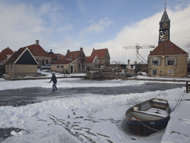On thin ice, and a long course, with the Dutch
 When organizers announced Wednesday night that the Elfstedentocht — the Netherlands' mythical Eleven Cities Tour — would not be staged because the ice was too dangerous, a colleague suggested I skate the waterways that make up the course for a story.
When organizers announced Wednesday night that the Elfstedentocht — the Netherlands' mythical Eleven Cities Tour — would not be staged because the ice was too dangerous, a colleague suggested I skate the waterways that make up the course for a story.
I'm not sure he knew the tour is 125 miles (200 kilometers) long.
I don't even like driving that far.
I was born in Australia. I don't have skating hardwired into my DNA like most Dutch people. I didn't push a chair around a frozen lake as a child the way Dutch kids do to learn how to skate.
But despite all that, I love skating and the fact that I'm terrible at it does not deter me.
Waiting for a long gap between the passing skaters, I step into the middle of the ice and push onwards. I dodge a solid mound of ice in midstream and duck under a bridge only to lose my balance as I hit softer ice (water freezes more slowly under bridges, I'm told). It's like skating through ice cream instead of on ice.
Somehow I manage to stay upright long enough to reach a 90 degree bend to the left. To the right was a lock and — this can't be right — a big hole in the ice with a heron staring stoically into the murky depths hoping for a feed.
Like Eskimos and snow, the Dutch have a mini-vocabulary dedicated to ice skating. A hole in the ice is called a "wak", there is a verb — "klunen" — for clambering along the river bank in your skates.
Every time I look up, people are cruising by me with both hands behind their backs, dressed aerodynamically in layers of tight-fitting clothes. Many take their hands out from behind their backs to record videos on their mobile phones as they speed through the picture-postcard prettiness.
These people are not going to let a small detail like the Elfstedentocht not being staged spoil their fun.
In fact, many of them say they like the fact that the ice has been meticulously scraped clean by a small army of volunteers in an effort to make it strong enough to stage a race with 16,000 competitors. And because the official race is not on, the pace is easier, the ice not so busy.
"It's a pity it didn't happen, but it's great for skating today for me — the ice is well prepared and the atmosphere is fantastic," says Ben Nijman, 56, as he warms up in a canalside cafe.
Nijman said it is also safer. "In a tour, everybody is in a hurry, people get impatient."
Almost everybody who passes me on the ice smiles and says "Dag," Dutch for "Hi."
People ask one another for tips — what's the ice like in Balk? "Garbage." Is this the actual Elfstedentocht route? Yep. There's a camaraderie among the skaters that warms you even on this freezing day.
There was no way I would have finished the course. It would take me at least 12 hours if I were to survive, which I almost certainly would not.
(I once skated 30 kilometers (20 miles) across a frozen lake in the 1990s, but only finished because my wife, who is Dutch, pushed me the last third of the way.)
Associated Press photographer Peter Dejong didn't help, either. His skates — blades mounted in wood that you strap under regular shoes — broke within the first five meters (yards). The ancient leather straps had dried out and snapped as soon as he pushed off.
So I went off alone, skating for an hour around and around the beautiful town of Hindeloopen.
I passed an empty stall where competitors in the Elfstedentocht would have stopped to get a card stamped by race officials to prove they'd gotten that far — one of several such stamping stations. If you reach the finish line in the tour without having picked up all your stamps organizers will not give you the coveted small cross awarded to all finishers.
Eventually, my feet aching and cold, I hobbled off the ice and "kluned" to a cafe where I restored myself with typical Dutch skating fare: pea soup laced with thick slices of smoked sausage and a shot of Berenburg, a spicy gin-like drink that warms all extremities in an instant.
And I start dreaming of taking part in a real Elfstedentocht.
What the stars mean:
★ Poor ★ ★ Promising ★★★ Good ★★★★ Very good ★★★★★ Exceptional
 Tag:
Tag:
Latest News
More News
- Tropical storm Trami leaves at least 24 people dead in Philippines (October 24, 2024 | 17:36)
- Singapore grants conditional approval for solar power import from Australia (October 24, 2024 | 17:27)
- ASEAN digital economy set to reach $2 trillion by 2030 (October 22, 2024 | 15:08)
- Thailand asks Laos to waive visa fee at border checkpoints to boost tourism (October 21, 2024 | 17:23)
- Laos pledges to continue efforts to empower girls (October 21, 2024 | 17:17)
- Chinese electric vehicle maker to build plant in Indonesia (October 21, 2024 | 17:12)
- Vietnam Elevator Association introduces Elevator Safety Application to the world (October 18, 2024 | 09:00)
- A taste of the future - the go-to spot at the Worldchefs Congress & Expo 2024 (October 15, 2024 | 16:11)
- Jakarta to impose household waste levy (October 14, 2024 | 16:49)
- China, Laos plan to build connectivity development corridor with Thailand (October 14, 2024 | 16:19)




















 Mobile Version
Mobile Version